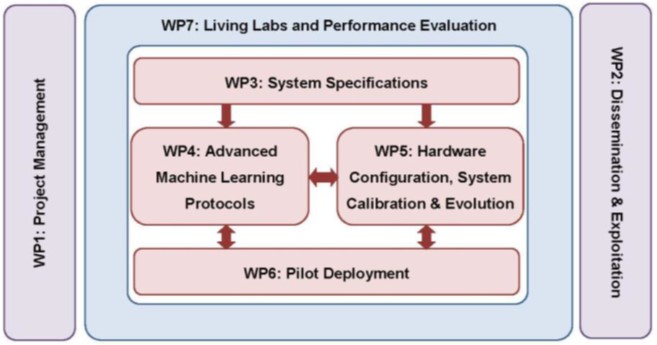The project activities will be implemented with a set of seven (7) interconnected work packages (WP), structured to reflect the general proposal objectives.

WP1 Project Management (Leader: CUT)
This WP covers all consortium activities concerning administration and technical coordination, including financial and technical reporting aspects, and overseeing progress within the project including deliverables.
WP2 Dissemination and Exploitation Activities (Leader: CUT)
This WP covers development of the LightSense exploitation plan together with public dissemination activities, including communication of activities to general public and outreach.
WP3 System Specifications (Leader: CUT)
This WP is the starting point of LightSense, as it drives the mutual understanding between the project partners regarding the open challenges, the needs and the feasible technological solutions that will define the foundation of the LightSense approach, as well as a new set of desired KPIs reflecting the requirements of the eventual field trials. Select partners will participate in a series of targeted hands-on workshops so that a detailed specification document is produced at the early project stages. This document will be frequently revisited as the project evolves, to ensure the successful completion of the project objectives.
WP4 Advanced Machine Learning Protocols (Leader: CUT)
The core deliverable of this WP will be a carefully crafted set of tailor-made and innovative machine learning algorithms for addressing the key research challenges of LightSense; namely, predictive fault detection for proactive maintenance intervention, and timely threat/intrusion detection. The developments of this WP will be founded upon the system specification outcomes of WP3 and will proceed in a synergistic fashion with the activities of WP5. The synchronisation of the activities of the two technical WPs (4 & 5) is of utmost importance, as the qualitative characteristics and the statistical properties of the obtained optical sensing data will determine the WP4 optimal research direction.
WP5 Hardware Configuration, System Calibration & Evolution (Leader: CUT)
The direction of this WP is defined by the initial interactions (WP3) between the appropriate project partners that will define the primary physical measurement requirements for transmission grid lines, considering: i) the physical integrity and performance characteristics of overhead and underground cables; ii) the timely and precise localisation of threat to infrastructure. Measurements will be made to calibrate optical fibres collocated with power cables to the presence of external perturbations prior to the distributed optical sensor system deployment in the field. Field measurements will ultimately be compared with laboratory scenarios and error sources identified. The captured data will be processed with the machine learning algorithms developed in WP4.
WP6 Pilot Deployment (Leader: EAC)
The system components resulting from the unique synergies of the technical work pages (WP4 & 5), as informed from the specification workshops of WP3, will be integrated into a coherent system for intelligent optical sensing and predictive policy guidance for electricity grid operators. The ultimate goal of WP6 is to perform this integration exercise and produce a pilot for deployment within the EAC processes. This will require the close collaboration of EAC with all partners and will allow for the field testing of LightSense outcomes, with objective evaluation in view of the defined KPIs, as determined in WP3. Moreover, these outcomes will offer solid feedback for iterative technology evolution and refinement during the project lifetime and beyond.
WP7 Living Labs and Performance Evaluation (Leader: CCS)
The primary goal of this work package is to actively and formally engage all relevant stakeholders in evaluating the overall progress and results of this project. The Living Labs are meetings with all interested stakeholders from various backgrounds (e.g., local authorities, the private sector, civil society organisations, and research institutions) that enable interactive communication in order to find and prioritise problems, requirements, and solutions towards common needs. The output of the Living Labs will inform on the activities of WP4–WP6. Once solutions are implemented, WP7 will assess and summarise the main WP findings, while evaluating the benefits and results, according to the views and perspectives of the stakeholders.